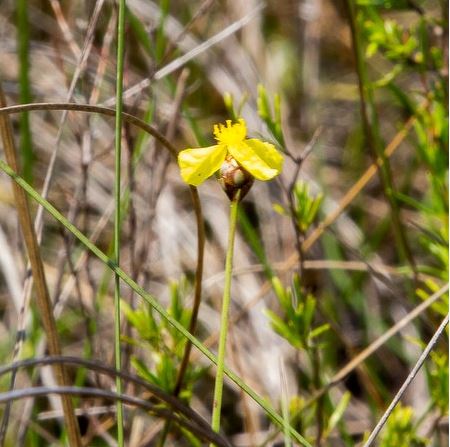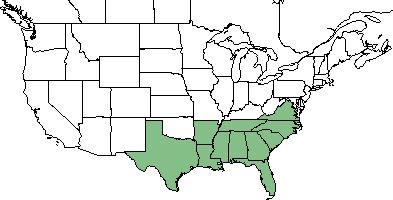Difference between revisions of "Xyris ambigua"
(→Ecology) |
HaleighJoM (talk | contribs) (→Ecology) |
||
| (7 intermediate revisions by 2 users not shown) | |||
| Line 22: | Line 22: | ||
==Description== | ==Description== | ||
<!-- Basic life history facts such as annual/perrenial, monoecious/dioecious, root morphology, seed type, etc. --> | <!-- Basic life history facts such as annual/perrenial, monoecious/dioecious, root morphology, seed type, etc. --> | ||
| − | Also known as coastal plain yelloweyed grass, ''X. ambigua'' is a native perennial forb that is a member of the Xyridaceae family.<ref name= "USDA"> USDA Plants Database URL: https://plants.usda.gov/core/profile?symbol=XYAM</ref> The leaves are broadly linear, 15-40 cm long, curvate | + | Also known as coastal plain yelloweyed grass, ''X. ambigua'' is a native perennial forb that is a member of the Xyridaceae family.<ref name= "USDA"> USDA Plants Database URL: https://plants.usda.gov/core/profile?symbol=XYAM</ref> The leaves are broadly linear, 15-40 cm long, curvate or slightly twisted, and its tips are either blunt or acute. Bracts range from reddish-brown to pale brown, while lateral sepals are tan to reddish with a broad, ciliate keel.<ref name= "Kral"> Kral, R. (1960). "The genus Xyris in Florida." Rhodora 62(743): 295-319.</ref> |
==Distribution== | ==Distribution== | ||
| − | + | ''X. ambigua'' is native to the southeast United States, ranging from eastern Texas to Virginia, mostly occupying areas along the coastline.<ref name= "USDA"/> | |
==Ecology== | ==Ecology== | ||
===Habitat=== <!--Natural communities, human disturbed habitats, topography, hydrology, soils, light, fire regime requirements for removal of competition, etc.--> | ===Habitat=== <!--Natural communities, human disturbed habitats, topography, hydrology, soils, light, fire regime requirements for removal of competition, etc.--> | ||
| − | ''X. ambigua'' can be found in communities that are not human disturbed, ranging from wet savannahs and flatwoods to pinelands and edges of depression ponds.<ref name= "Weakley"> Weakley, A. S. (2015). Flora of the Southern and Mid-Atlantic States. Chapel Hill, NC, University of North Carolina Herbarium.</ref> Other communities include moist sands or sandy-peats of bog margins | + | ''X. ambigua'' can be found in communities that are not human disturbed, ranging from wet savannahs and flatwoods to pinelands and edges of depression ponds.<ref name= "Weakley"> Weakley, A. S. (2015). Flora of the Southern and Mid-Atlantic States. Chapel Hill, NC, University of North Carolina Herbarium.</ref> Other communities include moist sands or sandy-peats of bog margins and lakeshores.<ref name= "Kral"/> As well, ''X. ambigua'' has been observed in a range of habitats including moist loamy sand in disturbed sites and savannahs, moist sandy peat in cypress domes, wet sandy peat in pine flatwoods, wet acid sands, and other bogs.<ref name= "Herbarium"> Florida State University Robert K. Godfrey Herbarium database. URL: http://herbarium.bio.fsu.edu. Last accessed: June 2018. Collectors: Loran C. Anderson, Steve L. Orzell, Edwin L. Bridges, R. Kral, R. K. Godfrey, O. Lakela, P. L. Redfeam, Robert L. Lazor, Sidney McDaniel, Wilson Baker, Ann F. Johnson, Wendy Casper, Bob Rjce, K. Craddock Burks, A. H. Curtiss, John Morrill, N. C. Henderson, Bruce Hansen, M. Davis, R. A. Norris, A. F. Clewell, Cecil R. Slaughter, T. MacClendon, K. MacClendon, and A. Gholson. States and counties: Florida: Wakulla, Nassau, Franklin, Gulf, Liberty, Martin, Leon, Citrus, Collier, Charlotte, Brevard, Jackson, Hillsborough, Orange, Bay, Walton, Okaloosa, Levy, Escambia, Santa Rosa, Holmes, Washington, Calhoun, Pasco, Jefferson, Palm Beach, Indian River, Lee, Hernando, Pinellas, Taylor, Duval, and St. Johns. Georgia: Thomas, Grady, and Coffee. Alabama: Escambia and Calhoun.</ref> It increased in frequency and biomass in response to soil disturbance by clearcutting and chopping in north Florida flatwoods forests.<ref>Moore, W.H., B.F. Swindel, and W.S. Terry. (1982). Vegetative Response to Clearcutting and Chopping in a North Florida Flatwoods Forest. Journal of Range Management 35(2):214-218.</ref> |
| + | |||
| + | ''Xyris ambigua'' is frequent and abundant in the North Florida Wet Flatlands community type and is an indicator species for the Lower Panhandle Savannas community type as described in Carr et al. (2010).<ref>Carr, S.C., K.M. Robertson, and R.K. Peet. 2010. A vegetation classification of fire-dependent pinelands of Florida. Castanea 75:153-189.</ref> | ||
Associated species - ''Scleria reticularis'', ''Buchnera floridana'', ''Hypericum opacum'', ''Eryngium integrifolium'', ''Xyris elliottii'', ''Habenaria integra'', ''Polygala ramosa'', ''Polygala lutea'', ''Ctenium aromaticum'', ''Hibiscus aculeatus'', ''Xyris brevifolia'', ''Xyris caroliniana''.<ref name= "Herbarium"/> | Associated species - ''Scleria reticularis'', ''Buchnera floridana'', ''Hypericum opacum'', ''Eryngium integrifolium'', ''Xyris elliottii'', ''Habenaria integra'', ''Polygala ramosa'', ''Polygala lutea'', ''Ctenium aromaticum'', ''Hibiscus aculeatus'', ''Xyris brevifolia'', ''Xyris caroliniana''.<ref name= "Herbarium"/> | ||
| − | |||
| − | |||
===Phenology=== <!--Timing off flowering, fruiting, seed dispersal, and environmental triggers. Cite PanFlora website if appropriate: http://www.gilnelson.com/PanFlora/ --> | ===Phenology=== <!--Timing off flowering, fruiting, seed dispersal, and environmental triggers. Cite PanFlora website if appropriate: http://www.gilnelson.com/PanFlora/ --> | ||
| Line 41: | Line 41: | ||
===Fire ecology=== <!--Fire tolerance, fire dependence, adaptive fire responses--> | ===Fire ecology=== <!--Fire tolerance, fire dependence, adaptive fire responses--> | ||
| − | ''X. ambigua'' has shown significant increase in flowering response due to the introduction of fire.<ref name= "Hinman"> Hinman, S. E. and J. S. Brewer (2007). "Responses of Two Frequently-Burned Wet Pine Savannas to an Extended Period without Fire." The Journal of the Torrey Botanical Society 134(4): 512-526.</ref> | + | ''X. ambigua'' has shown significant increase in flowering response due to the introduction of fire.<ref name= "Hinman"> Hinman, S. E. and J. S. Brewer (2007). "Responses of Two Frequently-Burned Wet Pine Savannas to an Extended Period without Fire." The Journal of the Torrey Botanical Society 134(4): 512-526.</ref> Populations of this species have been known to persist through repeated annual burning.<ref>Platt, W.J., R. Carter, G. Nelson, W. Baker, S. Hermann, J. Kane, L. Anderson, M. Smith, K. Robertson. 2021. Unpublished species list of Wade Tract old-growth longleaf pine savanna, Thomasville, Georgia.</ref> |
| − | <!--===Pollination and | + | <!--===Pollination===--> |
| + | <!--===Herbivory and toxicology=== <!--Common herbivores, granivory, insect hosting, poisonous chemicals, allelopathy, etc.--> | ||
<!--==Diseases and parasites==--> | <!--==Diseases and parasites==--> | ||
Latest revision as of 17:32, 18 July 2022
Common names: coastal plain yelloweyed grass
| Xyris ambigua | |
|---|---|

| |
| Photo by John Bradford hosted at Bluemelon.com/poaceae | |
| Scientific classification | |
| Kingdom: | Plantae |
| Division: | Magnoliophyta - Flowering plants |
| Class: | Liliopsida - Moncots |
| Order: | Commelinales |
| Family: | Xyridaceae |
| Genus: | Xyris |
| Species: | X. ambigua |
| Binomial name | |
| Xyris ambigua Kunth | |

| |
| Natural range of Xyris ambigua from USDA NRCS Plants Database. | |
Contents
Taxonomic Notes
Description
Also known as coastal plain yelloweyed grass, X. ambigua is a native perennial forb that is a member of the Xyridaceae family.[1] The leaves are broadly linear, 15-40 cm long, curvate or slightly twisted, and its tips are either blunt or acute. Bracts range from reddish-brown to pale brown, while lateral sepals are tan to reddish with a broad, ciliate keel.[2]
Distribution
X. ambigua is native to the southeast United States, ranging from eastern Texas to Virginia, mostly occupying areas along the coastline.[1]
Ecology
Habitat
X. ambigua can be found in communities that are not human disturbed, ranging from wet savannahs and flatwoods to pinelands and edges of depression ponds.[3] Other communities include moist sands or sandy-peats of bog margins and lakeshores.[2] As well, X. ambigua has been observed in a range of habitats including moist loamy sand in disturbed sites and savannahs, moist sandy peat in cypress domes, wet sandy peat in pine flatwoods, wet acid sands, and other bogs.[4] It increased in frequency and biomass in response to soil disturbance by clearcutting and chopping in north Florida flatwoods forests.[5]
Xyris ambigua is frequent and abundant in the North Florida Wet Flatlands community type and is an indicator species for the Lower Panhandle Savannas community type as described in Carr et al. (2010).[6]
Associated species - Scleria reticularis, Buchnera floridana, Hypericum opacum, Eryngium integrifolium, Xyris elliottii, Habenaria integra, Polygala ramosa, Polygala lutea, Ctenium aromaticum, Hibiscus aculeatus, Xyris brevifolia, Xyris caroliniana.[4]
Phenology
X. ambigua has been observed to flower June through September and November.[7] Flowers close before noon when blooming.[8]
Fire ecology
X. ambigua has shown significant increase in flowering response due to the introduction of fire.[9] Populations of this species have been known to persist through repeated annual burning.[10]
Conservation, cultivation, and restoration
This species is listed as endangered in the state of Tennessee.[1]
Cultural use
Photo Gallery
References and notes
- ↑ 1.0 1.1 1.2 USDA Plants Database URL: https://plants.usda.gov/core/profile?symbol=XYAM
- ↑ 2.0 2.1 Kral, R. (1960). "The genus Xyris in Florida." Rhodora 62(743): 295-319.
- ↑ Weakley, A. S. (2015). Flora of the Southern and Mid-Atlantic States. Chapel Hill, NC, University of North Carolina Herbarium.
- ↑ 4.0 4.1 Florida State University Robert K. Godfrey Herbarium database. URL: http://herbarium.bio.fsu.edu. Last accessed: June 2018. Collectors: Loran C. Anderson, Steve L. Orzell, Edwin L. Bridges, R. Kral, R. K. Godfrey, O. Lakela, P. L. Redfeam, Robert L. Lazor, Sidney McDaniel, Wilson Baker, Ann F. Johnson, Wendy Casper, Bob Rjce, K. Craddock Burks, A. H. Curtiss, John Morrill, N. C. Henderson, Bruce Hansen, M. Davis, R. A. Norris, A. F. Clewell, Cecil R. Slaughter, T. MacClendon, K. MacClendon, and A. Gholson. States and counties: Florida: Wakulla, Nassau, Franklin, Gulf, Liberty, Martin, Leon, Citrus, Collier, Charlotte, Brevard, Jackson, Hillsborough, Orange, Bay, Walton, Okaloosa, Levy, Escambia, Santa Rosa, Holmes, Washington, Calhoun, Pasco, Jefferson, Palm Beach, Indian River, Lee, Hernando, Pinellas, Taylor, Duval, and St. Johns. Georgia: Thomas, Grady, and Coffee. Alabama: Escambia and Calhoun.
- ↑ Moore, W.H., B.F. Swindel, and W.S. Terry. (1982). Vegetative Response to Clearcutting and Chopping in a North Florida Flatwoods Forest. Journal of Range Management 35(2):214-218.
- ↑ Carr, S.C., K.M. Robertson, and R.K. Peet. 2010. A vegetation classification of fire-dependent pinelands of Florida. Castanea 75:153-189.
- ↑ Nelson, G. PanFlora: Plant data for the eastern United States with emphasis on the Southeastern Coastal Plains, Florida, and the Florida Panhandle. www.gilnelson.com/PanFlora/ Accessed: 29 MAY 2018
- ↑ Comment by Edwin Bridges on post by Rodney Felix, Walton County, May 8, 2017, posted to Florida Flora and Ecosystematics Facebook Group.
- ↑ Hinman, S. E. and J. S. Brewer (2007). "Responses of Two Frequently-Burned Wet Pine Savannas to an Extended Period without Fire." The Journal of the Torrey Botanical Society 134(4): 512-526.
- ↑ Platt, W.J., R. Carter, G. Nelson, W. Baker, S. Hermann, J. Kane, L. Anderson, M. Smith, K. Robertson. 2021. Unpublished species list of Wade Tract old-growth longleaf pine savanna, Thomasville, Georgia.